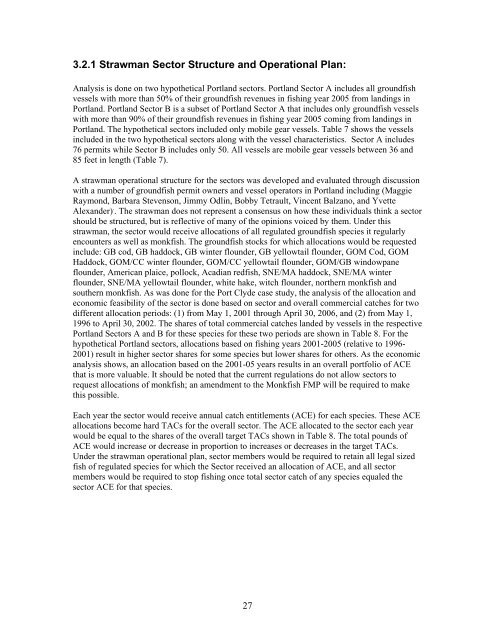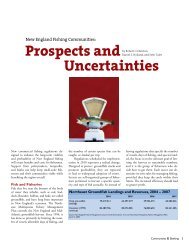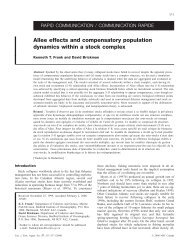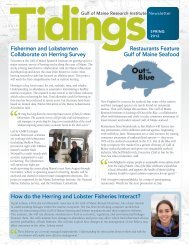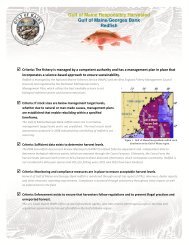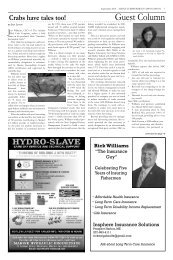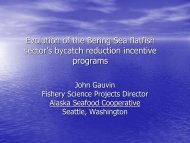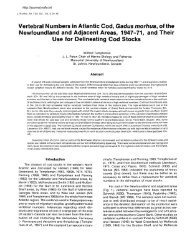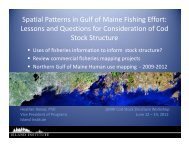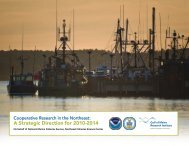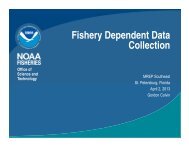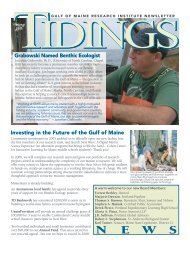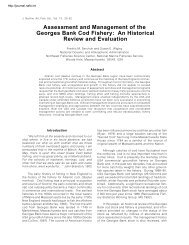Community-based Sectors for the New England Groundfish Fishery
Community-based Sectors for the New England Groundfish Fishery
Community-based Sectors for the New England Groundfish Fishery
Create successful ePaper yourself
Turn your PDF publications into a flip-book with our unique Google optimized e-Paper software.
3.2.1 Strawman Sector Structure and Operational Plan:<br />
Analysis is done on two hypo<strong>the</strong>tical Portland sectors. Portland Sector A includes all groundfish<br />
vessels with more than 50% of <strong>the</strong>ir groundfish revenues in fishing year 2005 from landings in<br />
Portland. Portland Sector B is a subset of Portland Sector A that includes only groundfish vessels<br />
with more than 90% of <strong>the</strong>ir groundfish revenues in fishing year 2005 coming from landings in<br />
Portland. The hypo<strong>the</strong>tical sectors included only mobile gear vessels. Table 7 shows <strong>the</strong> vessels<br />
included in <strong>the</strong> two hypo<strong>the</strong>tical sectors along with <strong>the</strong> vessel characteristics. Sector A includes<br />
76 permits while Sector B includes only 50. All vessels are mobile gear vessels between 36 and<br />
85 feet in length (Table 7).<br />
A strawman operational structure <strong>for</strong> <strong>the</strong> sectors was developed and evaluated through discussion<br />
with a number of groundfish permit owners and vessel operators in Portland including (Maggie<br />
Raymond, Barbara Stevenson, Jimmy Odlin, Bobby Tetrault, Vincent Balzano, and Yvette<br />
Alexander) . . The strawman does not represent a consensus on how <strong>the</strong>se individuals think a sector<br />
should be structured, but is reflective of many of <strong>the</strong> opinions voiced by <strong>the</strong>m. Under this<br />
strawman, <strong>the</strong> sector would receive allocations of all regulated groundfish species it regularly<br />
encounters as well as monkfish. The groundfish stocks <strong>for</strong> which allocations would be requested<br />
include: GB cod, GB haddock, GB winter flounder, GB yellowtail flounder, GOM Cod, GOM<br />
Haddock, GOM/CC winter flounder, GOM/CC yellowtail flounder, GOM/GB windowpane<br />
flounder, American plaice, pollock, Acadian redfish, SNE/MA haddock, SNE/MA winter<br />
flounder, SNE/MA yellowtail flounder, white hake, witch flounder, nor<strong>the</strong>rn monkfish and<br />
sou<strong>the</strong>rn monkfish. As was done <strong>for</strong> <strong>the</strong> Port Clyde case study, <strong>the</strong> analysis of <strong>the</strong> allocation and<br />
economic feasibility of <strong>the</strong> sector is done <strong>based</strong> on sector and overall commercial catches <strong>for</strong> two<br />
different allocation periods: (1) from May 1, 2001 through April 30, 2006, and (2) from May 1,<br />
1996 to April 30, 2002. The shares of total commercial catches landed by vessels in <strong>the</strong> respective<br />
Portland <strong>Sectors</strong> A and B <strong>for</strong> <strong>the</strong>se species <strong>for</strong> <strong>the</strong>se two periods are shown in Table 8. For <strong>the</strong><br />
hypo<strong>the</strong>tical Portland sectors, allocations <strong>based</strong> on fishing years 2001-2005 (relative to 1996-<br />
2001) result in higher sector shares <strong>for</strong> some species but lower shares <strong>for</strong> o<strong>the</strong>rs. As <strong>the</strong> economic<br />
analysis shows, an allocation <strong>based</strong> on <strong>the</strong> 2001-05 years results in an overall portfolio of ACE<br />
that is more valuable. It should be noted that <strong>the</strong> current regulations do not allow sectors to<br />
request allocations of monkfish; an amendment to <strong>the</strong> Monkfish FMP will be required to make<br />
this possible.<br />
Each year <strong>the</strong> sector would receive annual catch entitlements (ACE) <strong>for</strong> each species. These ACE<br />
allocations become hard TACs <strong>for</strong> <strong>the</strong> overall sector. The ACE allocated to <strong>the</strong> sector each year<br />
would be equal to <strong>the</strong> shares of <strong>the</strong> overall target TACs shown in Table 8. The total pounds of<br />
ACE would increase or decrease in proportion to increases or decreases in <strong>the</strong> target TACs.<br />
Under <strong>the</strong> strawman operational plan, sector members would be required to retain all legal sized<br />
fish of regulated species <strong>for</strong> which <strong>the</strong> Sector received an allocation of ACE, and all sector<br />
members would be required to stop fishing once total sector catch of any species equaled <strong>the</strong><br />
sector ACE <strong>for</strong> that species.<br />
27


